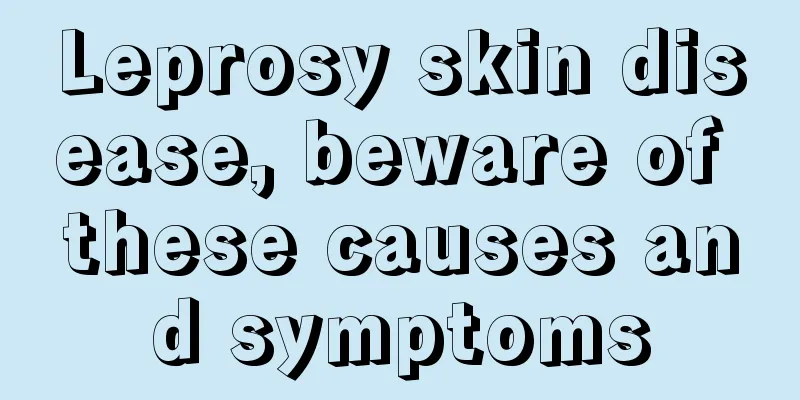Leprosy skin disease, beware of these causes and symptoms

|
Leprosy skin disease is a disease with an incubation period. The incubation period of leprosy is very long, and it generally stays dormant in the body for about 2 to 5 years. Some patients have very poor immunity and are plagued by some diseases all year round. Leprosy may appear in a few months. Some people even have strong resistance, and the troublesome virus is not easy to break out. It stays dormant in the body for about ten years. There are such cases. The occurrence of leprosy is related to the strength of personal immunity. After the occurrence of leprosy skin disease, in addition to skin rashes, the skin mucosa, peripheral nerves, and lymph nodules will be damaged to varying degrees, and it will have a certain impact on the whole body system. In addition to physical health examinations, adjustments should be made in all aspects, and medical medications should be used to inhibit repeated invasion of the virus. Causes Leprosy patients are the natural hosts of Mycobacterium leprae. Mycobacterium leprae is widely distributed in the patient's body, mainly in the skin, mucous membranes, peripheral nerves, lymph nodes, liver, spleen and other reticuloendothelial systems. Inside certain cells. Mycobacterium leprae is mainly excreted from the body through broken skin and mucous membranes. It is also found in breast milk, tears, semen and vaginal secretions, but in very small quantities. Symptoms After Mycobacterium leprae invades the body, the incubation period is generally believed to be an average of 2 to 5 years, with the shortest being a few months and the longest being more than ten years. (I) Tuberculoid leprosy: Patients with this type have stronger immunity and the leprosy bacteria are confined to the skin and nerves. (ii) Borderline tuberculoid leprosy: This type of leprosy is similar to the tuberculoid type, with macules and plaques that are light red, purple red or brownish yellow in color, with clear and neat borders. Some plaques have "blank areas" or "hole areas" in the center, forming ring-shaped lesions with clear inner and outer edges. The skin within the hole area appears normal. (III) Intermediate borderline leprosy: This type of lesion is characterized by polymorphism and polychromy. (IV) Borderline hemimatous leprosy: This type of skin lesions include macules, papules, nodules, plaques and diffuse infiltration. (V) Lepromatous leprosy: Patients with this type of leprosy lack immunity to Mycobacterium leprae, which spreads throughout the body through lymph and blood. (VI) Undetermined leprosy: This category is the early manifestation of leprosy and is primary. It is not included in the five-level classification. It is unstable in nature and may disappear on its own or transform into other types. examine Test method and result judgment: Inject 0.1 ml of crude leprosy into the skin of the flexor side of the forearm to form a white bulge with a diameter of about 6 to 8 mm, and then observe the reaction results. Early reaction: Observe and judge the result 48 hours after injection. If there is an infiltrative erythema with a diameter greater than 20 mm at the injection site, it is a strong positive. (+++), 15-20 mm is moderately positive (++), 10-15 mm is weakly positive (+), 5-10 mm is suspicious (±), less than 5 mm or no reaction is negative (-); Late reaction: observe and judge the results 21 days after injection. The occurrence of red infiltrative nodules with ulceration at the injection site is strongly positive (+++), the diameter of the nodule infiltration is greater than 5 mm is moderately positive, the diameter of the nodule infiltration is 3-5 mm is weakly positive (+), mild nodule infiltration or less than 3 mm is suspicious (±), and no local reaction is negative (-). treat 1. Chemical drugs. (1) Diphenylsulfonate (DDS) is the drug of choice. (2) Chlorophenazine (B633) can not only inhibit Mycobacterium leprae, but also resist type II leprosy reactions. 100-200 mg/day, orally. (3) Rifampicin has a rapid killing effect on Mycobacterium leprae. 2. Immunotherapy. Specific immunotherapy with live BCG plus killed leprosy bacteria is being studied and can be carried out simultaneously with combination chemotherapy. |
<<: What are the main causes of lupus erythematosus skin disease
>>: What should I do if I am allergic to hair dye?
Recommend
Will external hemorrhoids go away on their own?
External hemorrhoids are a type of hemorrhoids. T...
How long after a failed IVF can I try again
The IVF method of pregnancy mainly involves remov...
Dietary conditioning methods for rectal cancer chemotherapy
Dietary conditioning for colorectal cancer chemot...
Experts tell you that adequate sleep can prevent cervical cancer
Many women suffer from cervical cancer, a gynecol...
What are the symptoms of spinal lymphoma
Lymphoma is a disgusting tumor. In the early stag...
How to treat damp-heat type acne
Damp-heat acne is a type of acne and is also a re...
Choose foods based on 8 high-quality nutrients to promote secretion and help breast enlargement
The reason why kudzu root, cabbage, miso soup, to...
The efficacy and function of white giant clam
If you like jade or are interested in the accesso...
Nasopharyngeal cancer is more likely to affect people with qi deficiency
Nasopharyngeal cancer is a common and disgusting ...
Differential diagnosis of kidney cancer
Most patients with kidney cancer think that their...
Preventive measures for cervical cancer
Among the many gynecological diseases in women, c...
Disadvantages of contact lenses
Many people suffer from myopia. Most traditional ...
How to store bird's nest after soaking
Because the soaking time of bird's nest is re...
Will early uterine cancer recur?
Uterine cancer actually refers to endometrial can...
Benefits of wheatgrass juice
Wheatgrass juice is a common drink in life. Many ...









